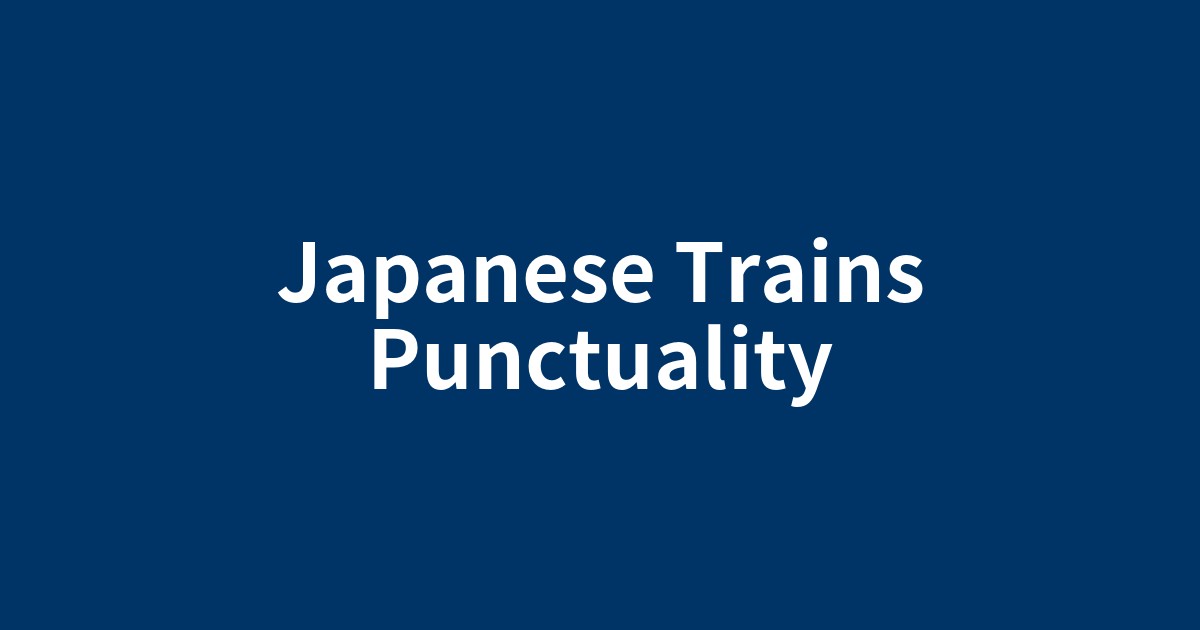このページは、歴史や文化の物語を楽しみながら、その文脈の中で重要な英単語を自然に学ぶための学習コンテンツです。各セクションの下にあるボタンで、いつでも日本語と英語を切り替えることができます。背景知識を日本語で学んだ後、英語の本文を読むことで、より深い理解と語彙力の向上を目指します。

世界が驚く、日本の鉄道の正確さ。その背景にある、緻密なダイヤグラム、高度な運行システム、そして職員の強いresponsibility(責任感)。
この記事で抑えるべきポイント
- ✓日本の鉄道が世界的に見て極めて高い定時性を誇る背景には、単一ではない複数の要因が複雑に絡み合っているという視点。
- ✓分秒単位で全列車の運行を計画・可視化する「ダイヤグラム」という、日本の鉄道システムの心臓部とも言える計画技術の存在。
- ✓ATC(自動列車制御装置)などに代表される、安全性と正確性を両立させるための高度な運行管理システムという技術的基盤。
- ✓システムを運用する運転士、指令員、保守作業員といった現場職員一人ひとりの強い責任感(responsibility)とプロ意識。
- ✓鉄道の正確性は、時間を守ることを社会的な美徳とする日本の文化や国民性と深く結びついている可能性があるという考察。
なぜ日本の電車は時間通りに来るのか
「まもなく、2番線に、10時15分発、快速、東京行きがまいります」。日本の駅で当たり前のように流れるこのアナウンス。私たちは、電車が時刻通りに来ることを疑いません。しかし、一歩海外に目を向ければ、この「当たり前」が、実は世界の標準ではないことに気づかされます。数分の遅れは日常茶飯事、時には数時間単位で乱れることも珍しくありません。では、なぜ日本の鉄道(railway)は、これほどまでに驚異的な正確さを保てるのでしょうか。その秘密を探る旅に出かけましょう。
Why Do Japanese Trains Arrive on Time?
"The 10:15 rapid train for Tokyo will soon be arriving on track 2." This is a common announcement heard at stations across Japan. We simply don't doubt that the train will arrive on schedule. However, if you look overseas, you'll realize that this "normality" is not, in fact, the global standard. Delays of a few minutes are common, and it's not unusual for schedules to be disrupted by hours. So, how does the Japanese railway maintain such astonishing accuracy? Let's embark on a journey to uncover its secrets.
神業の時刻表:ダイヤグラムという名の芸術
日本の鉄道の正確性を支える心臓部、それは「ダイヤグラム(diagram)」と呼ばれる運行計画図です。私たちが駅で目にする「時刻表(timetable)」は、このダイヤグラムを基に作られたものに過ぎません。ダイヤグラムは、縦軸に距離(駅)、横軸に時間をとり、全ての列車の運行を線で示した緻密な図です。どの列車が、いつ、どこを走っているのかが一目瞭然となります。これにより、過密な路線でも列車同士が衝突することなく、効率的にすれ違いや追い越しができるのです。それはまさに、秒単位で計算され尽くした、知恵と技術の芸術品と言えるでしょう。
The Miraculous Timetable: An Art Form Called Diagram
The heart that supports the accuracy of Japan's railways is an operational plan called a "diagram." The "timetable" we see at the station is merely created based on this diagram. A diagram is a detailed chart with distance (stations) on the vertical axis and time on the horizontal axis, showing the operation of all trains as lines. It makes it clear at a glance which train is running where and when. This allows for efficient passing and overtaking even on crowded routes without trains colliding. It is truly a work of art, a product of wisdom and skill calculated down to the second.
テクノロジーの力:安全と正確さを両立させる運行システム
緻密な計画を現実のものにするには、それを支えるハードウェアが必要です。日本の定時運行は、世界最先端の「テクノロジー(technology)」によって実現されています。その代表格が、ATC(自動列車制御装置)やATOS(東京圏輸送管理システム)といった運行管理「システム(system)」です。これらのシステムは、先行列車との距離を常に監視し、自動で速度を制御することで、高密度な運行と「安全性(safety)」を両立させます。人の感覚だけに頼るのではなく、テクノロジーの力でミスを未然に防ぎ、正確な運行を物理的に支えているのです。
The Power of Technology: An Operating System that Balances Safety and Accuracy
To turn a detailed plan into reality, you need the hardware to support it. Japan's on-time operation is made possible by world-class "technology." Representative examples include operational management "systems" like ATC (Automatic Train Control) and ATOS (Autonomous decentralized Transport Operation control System). These systems constantly monitor the distance to the preceding train and automatically control the speed, achieving both high-density operation and "safety." Rather than relying solely on human senses, the power of technology prevents errors before they occur and physically supports accurate operation.
見えざるヒーローたち:現場に根付く強いResponsibility(責任感)
しかし、どれほど優れた計画と技術があっても、それだけでは完璧な運行は実現できません。最後のピースを埋めるのは、現場で働く人々の力です。運転士、車掌、駅員、そして線路や車両を日々メンテナンスする保守作業員。彼ら一人ひとりが持つ強い「責任感(responsibility)」とプロ意識こそが、システム全体を動かす原動力です。秒単位の停車位置の調整、迅速な異常時の対応など、多くの職員による緊密な「連携(coordination)」が、日々の安定運行を支えています。彼らは、日本の鉄道という社会インフラを守る「見えざるヒーロー」なのです。
The Unseen Heroes: A Strong Sense of Responsibility Rooted in the Field
However, no matter how excellent the plan and technology, perfect operation cannot be achieved by them alone. The final piece of the puzzle is the power of the people working on the front lines. Drivers, conductors, station staff, and the maintenance crews who service the tracks and vehicles daily. The strong "responsibility" and professionalism of each and every one of them is the driving force that moves the entire system. Close "coordination" among many staff members, such as second-by-second adjustments of stopping positions and rapid responses to abnormalities, supports stable daily operations. They are the "unseen heroes" who protect the social infrastructure that is the Japanese railway.
定時性は文化か?社会が求める究極の正確さ
そもそも、なぜ日本ではこれほどまでに鉄道の「時間厳守(punctuality)」が求められるのでしょうか。この問いは、技術や個人の努力を超え、より大きなテーマへと繋がっていきます。時間を守ること、他者に迷惑をかけないことを社会的な美徳とする日本特有の「文化(culture)」が、鉄道サービスに高いレベルの正確さを求める素地となっているのかもしれません。利用者の厳しい目が、鉄道会社を常に緊張させ、世界一のサービスへと磨き上げさせてきた、という見方もできるでしょう。鉄道の正確さは、社会全体の価値観を映す鏡なのかもしれません。
Is Punctuality Culture? The Ultimate Accuracy Demanded by Society
In the first place, why is such "punctuality" demanded of railways in Japan? This question leads beyond technology and individual effort to a larger theme. The unique Japanese "culture," which values keeping time and not inconveniencing others as social virtues, may have created the foundation for demanding a high level of accuracy from railway services. One could also argue that the strict eyes of the users have constantly kept the railway companies on their toes, polishing their service to be the best in the world. The accuracy of the railway may be a mirror reflecting the values of society as a whole.
結論:奇跡の「当たり前」を支える三つの柱
日本の鉄道が誇る世界一の定時性は、決して一つの要因で成り立っているわけではありません。それは、全列車の動きを可視化する緻密な計画「ダイヤグラム(diagram)」、安全性と正確さを両立させる高度な運行管理「システム(system)」、そして現場の職員一人ひとりの強い「責任感(responsibility)」という三つの柱が、奇跡的なバランスで組み合わさって初めて実現される産物なのです。私たちが毎日利用するこの「当たり前」の裏側にある物語を知ることで、いつもの通勤風景が、少しだけ豊かで、誇らしいものに見えてくるのではないでしょうか。
Conclusion: The Three Pillars Supporting a Miraculous "Normality"
The world-class punctuality that Japanese railways boast is not built on a single factor. It is a product realized only when three pillars are combined in a miraculous balance: the detailed "diagram" that visualizes the movement of all trains, the advanced operating "system" that balances safety and accuracy, and the strong "responsibility" of each staff member on the ground. By knowing the story behind this "normality" that we use every day, perhaps our usual commuting scenery will appear a little richer and more pride-worthy.
テーマを理解する重要単語
culture
日本の「時間厳守」を技術や個人の努力だけでなく、「文化」というより大きな文脈で捉え直すために使われています。時間を守ることを美徳とする社会的な価値観が鉄道に影響を与えているという考察は、この記事に深みを与える重要な視点です。
文脈での用例:
I am interested in learning about Japanese culture, especially its food and traditions.
私は日本文化、特にその食事や伝統について学ぶことに興味があります。
system
ATCやATOSといった「運行管理システム」を指す言葉として使われています。個別の技術ではなく、複数の要素が連携して機能する「体系」というニュアンスが重要です。日本の鉄道が、様々な技術を統合した一つの巨大なシステムとして機能していることを示唆します。
文脈での用例:
The company is introducing a new computer system to improve efficiency.
その会社は効率を上げるために新しいコンピューターシステムを導入している。
responsibility
優れた計画や技術を支える最後のピースとして登場する「責任感」。現場で働く人々のプロ意識や使命感という、人間的な要素の重要性を強調する言葉です。日本の鉄道の強さが、技術だけでなく人の心によっても支えられていることを理解する鍵となります。
文脈での用例:
She takes her responsibilities as a manager very seriously.
彼女はマネージャーとしての責任を非常に真摯に受け止めている。
railway
この記事の主題である「鉄道」を指す基本単語です。単に列車を指す'train'とは異なり、線路や駅、運行会社などを含む鉄道システム全体を意味します。日本の鉄道がなぜ優れているのかという、記事全体の大きなテーマを理解するための出発点となる言葉です。
文脈での用例:
The Japanese railway system is known for its efficiency and punctuality.
日本の鉄道システムは、その効率性と時間厳守で知られています。
technology
日本の定時運行を支える第二の柱として挙げられるキーワードです。ATC(自動列車制御装置)などの具体例と共に語られており、単なる精神論ではなく、世界最先端の科学技術が日本の正確さを物理的に支えているという記事の論点を掴む上で不可欠です。
文脈での用例:
Modern technology has transformed the way we communicate.
現代のテクノロジーは私たちのコミュニケーション方法を一変させた。
disrupt
海外の鉄道では遅延が日常茶飯事で、時には運行が「混乱する」ことを示すために使われています。日本の安定した運行との鮮やかな対比を生み出し、日本の鉄道が達成していることの凄さを際立たせる効果を持つ、重要な動詞です。
文脈での用例:
The new technology is expected to disrupt the entire industry.
その新技術は業界全体を根底から覆すと予想されている。
diagram
日本の鉄道の正確性を支える心臓部として登場する最重要単語です。単なる「図表」ではなく、全列車の運行を秒単位で計画した「運行計画図」という専門的な意味合いを知ることで、日本の鉄道技術の緻密さと芸術性を深く理解することができます。
文脈での用例:
The teacher drew a diagram on the board to explain the water cycle.
先生は水の循環を説明するために、黒板に図を描きました。
safety
日本の鉄道は、速さや正確さだけでなく「安全性」を同時に追求している点が特徴です。この記事では、テクノロジーが定時性と安全性をいかに両立させているかが論じられています。この単語は、日本の鉄道が持つ多面的な価値を理解する上で欠かせません。
文脈での用例:
Safety is the top priority in the airline industry.
航空業界では安全が最優先事項です。
coordination
現場の人々が持つ責任感を、実際の安定運行に繋げるための具体的な行動を指すのが「連携」です。運転士や駅員、保守作業員といった多くの職員が緊密に連携する様子を想像することで、日本の鉄道という巨大な組織が円滑に動く仕組みを理解できます。
文脈での用例:
Effective coordination among G20 members is essential to tackle global economic problems.
世界的な経済問題に取り組むためには、G20メンバー間の効果的な調整が不可欠です。
punctuality
「時間厳守」を意味し、この記事の核心的なテーマを最も直接的に表す単語です。なぜ日本ではこれほどまでにpunctualityが求められるのか、という問いかけを通じて、話が技術論から文化論へと深まっていく、記事の転換点となる重要な言葉です。
文脈での用例:
Punctuality is considered a great virtue in his company.
彼の会社では、時間厳守は素晴らしい美徳だと考えられている。
astonishing
「驚くべき」という意味のこの形容詞は、日本の鉄道の正確性が世界的に見ていかに異常なレベルであるかを強調します。客観的な事実だけでなく、筆者が抱く驚嘆の念を伝えることで、読者を記事の世界観に引き込む効果を持つ言葉です。
文脈での用例:
She gave an astonishing performance that captivated the entire audience.
彼女は観客全員を魅了する驚くべきパフォーマンスを披露した。
timetable
日常で使う「時刻表」ですが、この記事では専門的な「ダイヤグラム」との対比で使われています。私たちが目にする時刻表が、実はより複雑で緻密な計画の表層に過ぎないことを理解することで、日本の鉄道システムの奥深さを感じ取ることができます。
文脈での用例:
Please check the timetable for the departure time of the last train.
最終電車の出発時刻は、時刻表で確認してください。
normality
日本では「当たり前」のこととして使われるこの単語が、記事の導入と結論で鍵となります。世界標準ではないこの「normality」が、いかに多くの努力と技術の結晶であるかを知ることが、この記事の目的そのものと言えるでしょう。
文脈での用例:
After the storm, everyone was hoping for a return to normality.
嵐の後、誰もが平常に帰ることを望んでいました。